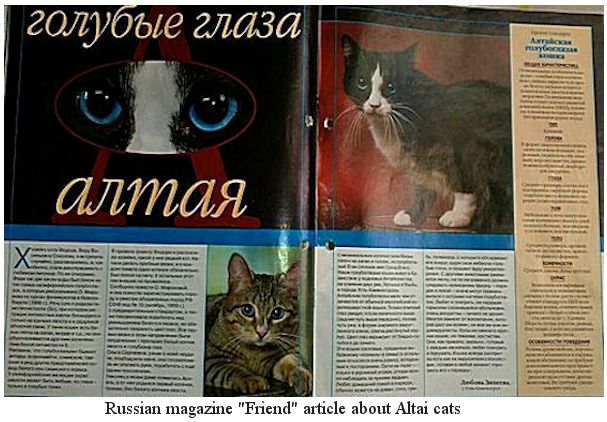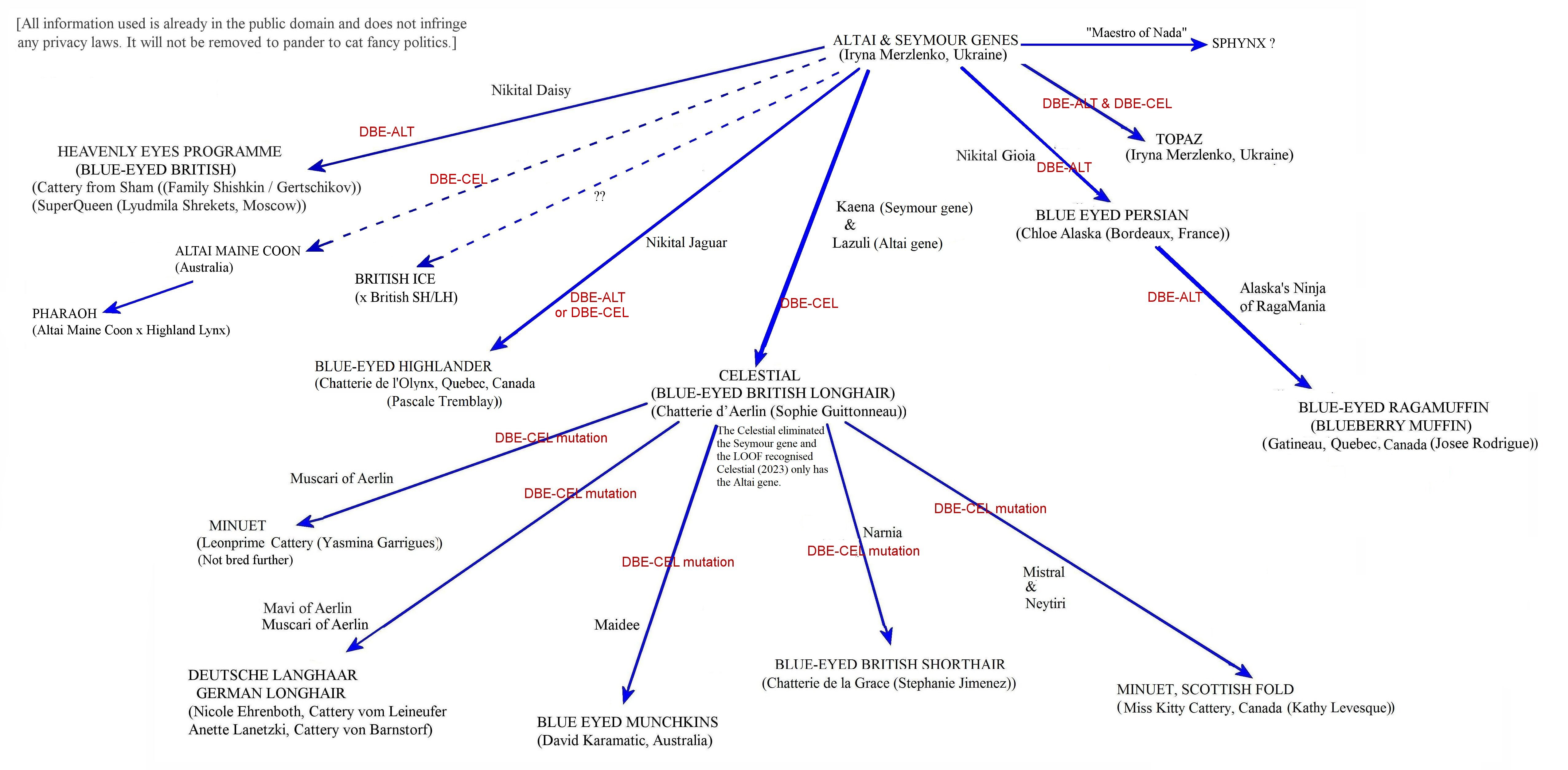
BLUE-EYED BREEDS - ALTAI (ALTAY)
ALTAI / ALTAY
Olga Volynska was the first to notice blue-eyed cats at a factory, but her report was largely ignored because conventional wisdom said that cats with blue-eyes and minimal or no white markings could not exist. A couple of years later (1984) the Ojos Azules was reported in a TICA journal.
HISTORY OF THE ALTAI BREED
In 1997, Lyubov Borisovna Zikeeva from Ust-Kamenogorsk (Kazakhstan) noticed blue-eyed cats on the street and decided to find out more. She had the Darlin (or Darlene) cattery and she became the first person who attempted to re-establish a truly blue-eyed breed. The first Ust-Kamenogorsk Altai was an ordinary domestic semi-long-haired cat, with white marks, blue right eye and yellow-green left eye. If the Ojos Azules could be recognised as a new breed on the basis of eye colour and small white marked, then the Altay could be recognised too! The cat magazine "Friend" (issue No. 8/9 August-September 2004) reported that the first owner of an Altai cat was Vera Sokolova, who lived in the city of Ust-Kamenogorsk in Kazakhstan. In 1995 or 1996 she owned a black cat called Fyodor who had blue eyes and a white tail-tip, a phenotype that resembled the American Ojos Azules discovered in California.

After talking with Fyodor's owner, Lyubov Zikeeva embarked on the creation of the Altay blue-eyed breed which has lasted more than twenty years and still continues today. Although Fyodor (gene: DBEALT) >mated many times with unrelated females, he rarely sired blue-eyed kittens unless his mates had the white spotting gene. After many unsuccessful matings, Lyubov Zikeeva was finally rewarded by the birth of a blue-eyed cat named Ariel, who is considered the progenitor of all living Altai cats. After breeding a blue-eyed kitten, Lyubov Zikeeva mated blue-eyed to blue-eyed intending to get a wholly blue-eyed litter. She immediately discovered that homozygotes (2 copies of the blue-eye gene) were viable (unlike homozygous Ojos Azules), they had more white than their parents, but were most often deaf. Knowing that this new gene was not lethal meant the Altai had realistic breed potential.
The Fyodor's DBEALT gene turned out to be dominant with incomplete penetrance. Kittens with one blue eye and the other green-yellow are heterozygotes and from the point of view of deafness should be used in breeding, while homozygotes with two blue eyes should not. Line-breeding for generations was used to fix the traits, but in the third generation an outcross to green-eyed European Shorthair was needed to prevent inbreeding depression. Another oddity is that some cats have the DBE gene but do not have blue eyes. These cats are known as latents and can produce blue-eyed offspring.
Her early "Altai" cats included Roxy/Roksi Darlin (gene: DBECEL tabby with white hind feet and white throat); Grand Yegan (tabby, white cheeks and chin); Ekatarina (tabby with white hind feet and white throat); Nils (tabby, white paws, muzzle and throat) and Ellie Darlin (blue-eyed black tuxedo pattern). The first (and possibly last) blue-eyed kitten from Fyodor was a black and white cat named Pani Darlin, born in 1999 from a green-eyed white Exotic Shorthair female, Deya Darlin who was the same age as Fyodor. Pani produced a black and white blue-eyed cat, Ariel Darlin (born 2001), who went on to became the most famous ancestor of Altai cat breed. This means there was a mix of Fyodor's DBEALT and Roxy's DBECEL genes.
By 2016, there were only a few breeders working with the Altai breed, although there were many working with the DBECEL (Roxi) gene which was being introduced into Western European breeds. One Altai breeder is the veterinarian Elena Lobasova (Murmansk, Russian Federation), the other is Anna Kalinichenko (Zaporozhye, Ukraine). "Wonderful Aquamarine" cattery, (Grin L.V. and Kalinichenko A.O., Ukraine), began breeding Altai cats in 2016 under the framework of the WCF registering body. Her ”Wonderful Aquamarine” studs in 2017 were Efimenty Veles Darlin (silver spotted tabby with blue and green odd eyes) and Sonny Sweet Dreams of Wonderful Aquamarine (blue-eyed red). A queen shown on the website is Missy Nikital (blue-eyed classic tabby tuxedo pattern). Efimenty Veles Darlin was bred by Lyubov Zikeeva and is a direct descendant of Fyodor, Deya, Pani, Ariel Darlin and other cats from the Altai breeding program in the same years.
Roxy Darlin is also an ancestor of the Altai breed, but he is more famous for founding the Topaz breed at Nikita'l cattery in Ukraine. Roxy's pedigree is a mystery. The rest of Lyubov Zikeeva's Altai cats were sold to different breeders and all trace of them seems to have been lost, along with their pedigrees. In 2024, Fyodor's/Seymour's offspring were found to have the DBEALT gene, while Roxy's descendents had a different mutation, DBECEL named after the Celestial breed.
SHE'S GOT IT aka Venus - TICA Trend Aug/Sep 2021, Vol 42, No 5, illustrated article by Helmi and Cat Gargill.
Venus (registered name She's Got It, Jagcat Cattery, Catherine And Jonathan Gargill) is a tortoiseshell Altai F-2, known in Russia as an Ojos Azules because that was the only classification available for registration of such cats at that time. Venus's new owner, Cat Gargill had helped Solveig Pflueger research the original Ojos Azules for TICA. Cat Gargill, had owned seven Ojos Azules, ex-ferals found in Connecticut, New Jersey, New York and Massachusetts states, which were exhibited as household pets. In light of recent DNA testing those cats, coming from different locations, may not all have had the same mutation. Venus was flown to Florida to found a new breeding line, she was TICA Best Household Pet Kitten 2020.
BREEDING AND BREED STANDARD
It is undesirable to cross two blue-eyed or odd-eyed Altay cats as this can lead to deaf cats with a high degree of white in the coat. Blue-eyed Altay should be bred to non-blue-eyed Altay variants, preferably to green-eyed variants. This produces strong and healthy offspring and a mix of blue-eyed, odd-eyed and green-eyed offspring. Unlike the American Ojos Azules, Altay cats do not have gross physical deformations associated with the mutation. Along with the Ukrainian Topaz breed they are mistakenly called "Russian Ojos Azules" by English speakers. Altay Blue-Eyed were used early on with Topaz which combines two different lines of blue-eyed cats, but which differs in white marking pattern and sometimes having black-roan fur.
In the Altai, the bright blue eyes, or odd eyes, can be combined with non-white cats. The breed code is ALT and it is recorded in the register of new breeds and cat colours by the Tribunal Commission of the SFF in 1999. In that year, a draft standard was created and registered for the Altai Blue-Eyed (also known as ABE for short). This old standard called for a rounded wedge shaped head, cheeks not very pronounced, straight nose, the transition to the forehead being smooth without indentation (the 2018 standard calls for a distinct stop), strong jaws and rounded chin. Eyes are round and medium sized, set slightly obliquely and are blue or odd-eyed. Ears are small with slightly rounded tips, slightly taller than they are wide at the base (the 2018 standard calls for large ears, very wide at the base). Body is rectangular, medium sized, strong, flexible and muscular. Legs are medium length, and paws are round. The colours are solids, tabbies or torties with or without white, and there is a distinctive white tail-tip which may extend to one-third the length of the tail. Blue-eyed Altai without any white are the most prized. Fur is short, dense, glossy and springy with a well-developed undercoat.
The experimental breed has been exhibited in non-competition classes or as household pets. Breeders considered this unfair because some Altai pedigrees now have 5 or 6 generations of Altai-to-Altai breeding and are maintained and registered, whereas household pets can be mongrels. A WCF standard for the Altai was drawn up in 2018 (Anna Kalinichenko) to promote the Altai as a distinct breed and differentiate it from the Ukrainian Topaz and Celestial British. It calls for a medium to large, muscular and sturdy cat with a dense coat, vivid blue eyes and non-pointed colours. Its vivid blue eyes are wide-set, oval and slightly tilted - their outer corners being above the level of the outer base of the ears. The eye-colour should be rich, vivid and uniform blue, blue-green or green, or odd-eyed with good contrast between the two eye colours. Any eye colour is permitted, but blue and green colours are preferred for exhibition-quality cats. Strabismus (crossed eyes) is a disqualifying fault.
The head is round (a modified wedge with the width being almost equal to the length), the muzzle is fairly short, the chin is firm, the whisker-pads and cheekbones are pronounced. The ears are large, very wide at the bases and low-set with tufted tips and ear furnishings. The forehead is rounded and the profile has a distinct stop. The neck is long, strong and muscular and proportionate to the head and body. The body is medium length, strongly boned and compact with a broad chest. Males are larger than females. Limbs are strong, medium-long and slender (not cobby) with the hind-legs being slightly longer than the forelegs. The paws are oval; polydactyly is not permitted. The tail is medium length (long tails are also permitted, but not short, kinked or bobbed tails) and well-furred. The fur is especially thick on the back, legs, muzzle, cheeks and ears, sides, and tail, and there must be no signs of baldness. The coat can be short or semi-long. All colours are allowed, including bicolour, although cats with as little white as possible are preferred. Solid white and colourpoint are not permitted.
Until 2030 it will be allowable to out-cross Altai cats with American and European Shorthair, British Shorthair, Bengal, Abyssinian, Somali, and Siberian to produce the correct conformation, but after May 1, 2030, out-crossing will be prohibited and only Altai-to-Altai matings will be allowed. However, breeding together two blue-eyed or odd-eyed Altai cats is not permitted because it may lead to deafness and white coats in cats homozygous for this dominant gene. Regarding deafness, the Altai gene has similar risks to "blue-eyed white" and "blue-eyed high-white bicolour" because the absence of melanocytes affects inner ear development as well as eye colour. Blue/odd-eyed Altai may only be bred to non-blue-eyed Altai (preferably green-eyed) which will produce litters with a mix of blue-eyes, odd-eyes and green-eyes.
Altai cats are friendly and adapt well to their environment. They are active, energetic, sociable and affectionate and take an interest in everything going on around them. They do not require excessive space and they get on well with other animals. No special care or attention is required beyond the normal care of a short-haired cat.
